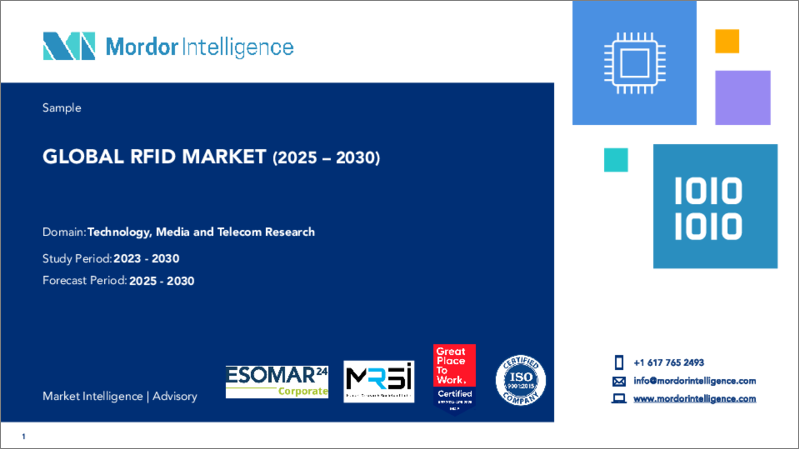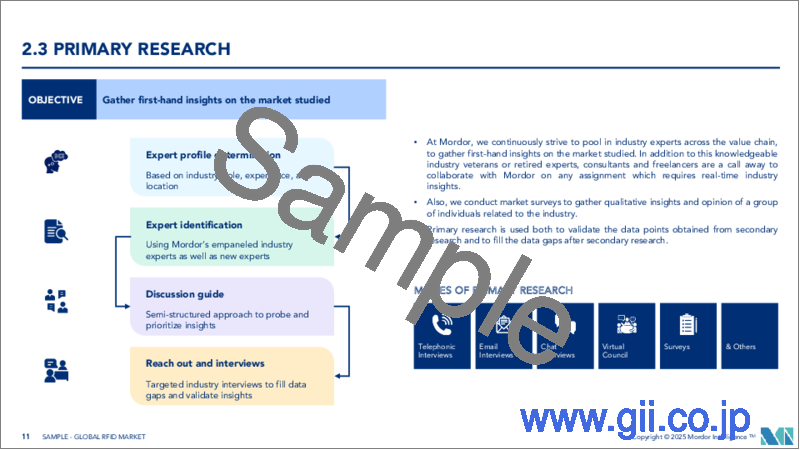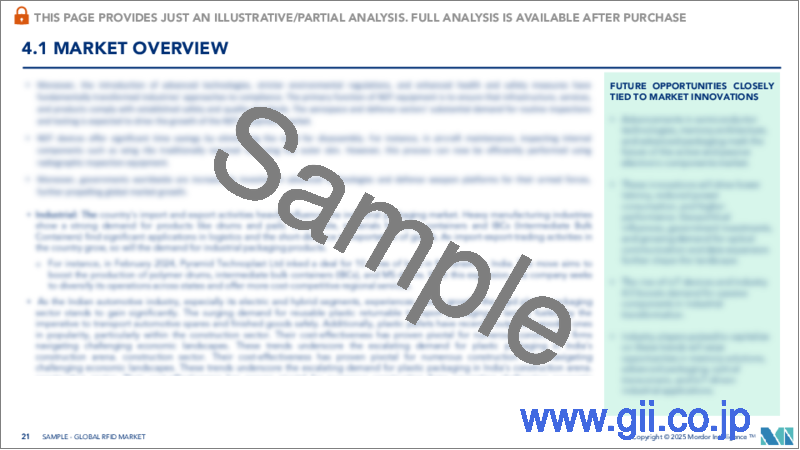|
|
市場調査レポート
商品コード
1690907
RFID:市場シェア分析、産業動向・統計、成長予測(2025年~2030年)RFID - Market Share Analysis, Industry Trends & Statistics, Growth Forecasts (2025 - 2030) |
||||||
カスタマイズ可能
適宜更新あり
|
|||||||
| RFID:市場シェア分析、産業動向・統計、成長予測(2025年~2030年) |
|
出版日: 2025年03月18日
発行: Mordor Intelligence
ページ情報: 英文 120 Pages
納期: 2~3営業日
|
全表示
- 概要
- 目次
RFID市場規模は2025年に167億3,000万米ドルと推計され、予測期間中(2025-2030年)のCAGRは11.68%で、2030年には290億6,000万米ドルに達すると予測されます。

サプライチェーン管理とロジスティクスでは、RFID技術が広く利用されています。センサーベースのRFID技術は、製品の原産地を追跡・追跡し、サプライチェーン内での汚染や改ざんの原因を防ぐために、製品包装への組み込みが進んでいます。
主なハイライト
- ロジスティクスと輸送は、RFID技術の主要な導入分野です。倉庫管理、ヤード管理、出荷・運送、配送センターなどは、通常RFID追跡技術が使用される分野の一部です。
- RFID(Radiofrequency Identification)とは、主にタグとリーダーという2つの主要コンポーネントからなる無線システムを指します。リーダは基本的に1つ以上のアンテナからなる装置で、電波を放射し、RFIDタグからの信号を受信します。タグは、電波を利用してIDやその他の重要な情報を近くのリーダに伝達するもので、パッシブタイプとアクティブタイプがあります。
- パッシブ型RFIDタグは、主にリーダーから電力を供給され、バッテリーを持たないです。しかし、アクティブタイプのRFIDタグは、バッテリーから電力を供給されます。これらのRFIDタグは、1つのシリアル番号から数ページの重要なデータまで、幅広い情報を保存することができます。RFIDリーダは、手で持ち運ぶことができるモバイル・フォーム・ファクタで提供されており、柱や頭上に取り付けることもできます。
- RFID技術の最も一般的な用途の一つは、サプライチェーンにおける商品の追跡、製造生産ラインに移動する部品の追跡、資産のトレース、セキュリティ、顧客が現金を使わずに商品の代金を支払う決済システムなどです。さらに、RFIDはヘルスケア産業で患者のリストバンドに頻繁に使用され、施設のアクセス制御やセキュリティのための改ざん防止された正確な識別を提供しています。
- さらに、世界中の複数の物流センターや倉庫が、改善プログラムの一環として、プロセス全体の効率を高めるために投資を行っています。市場情勢におけるこうした投資は、RFID技術の成長と導入を促進すると予想されています。
- COVID-19パンデミックは小売業者の課題を増大させました。パンデミックはまた、小売業者がRFIDをより大規模に導入するよう後押ししました。パンデミックは、すでに進行していたデジタルトランスフォーメーションの流れを加速させるものとなりました。
RFID市場の動向
小売セグメントが大きな市場シェアを占める見込み
- 小売業におけるRFIDは、RFIDリーダーに信号を発信するRFIDタグを商品に使用するもので、そのRFIDタグはソフトウェアによって処理され、取引、在庫管理、在庫レベル、個々の顧客の購買注文履歴などの結果をリアルタイムで提供します。小売業におけるRFIDは、手作業で時間がかかり、決められた間隔でしか実行されない典型的な小売業の棚卸プロセスを緩和します。商品追跡は、小売業者がRFIDを使用する主な用途の1つです。小売業におけるRFIDは、盗難を防止し、通常移動され、しばしば置き忘れられる商品を追跡するためにも使用できます。
- いくつかの企業が、在庫を管理するためのアプローチとしてRFIDを採用しています。Zara、H&M、 Target、Macy's、Uniqlo、Nike、Adidas、Lululemon、 Footlocker、Levi's、Tommy Hilfiger、 Ralph Lauren、Victoria's Secretなどが代表的です。eコマースは、店舗でのフルフィルメントやBOPIS(オンラインで購入し、店舗で受け取る)のようなプロセスをサポートするために、高い在庫精度が要求されることから、導入の大部分に拍車をかけています。
- RFID処理された商品はまた、経営陣が事実データを利用できるようになります。在庫精度はシュリンクを低減し、利益を向上させるために極めて重要であるため、RFIDはよりスマートな購買決定につながり、経営陣はより良い経費管理を行うことができます。
- RFIDを使用することで、全体的な商品管理が改善される可能性があります。また、販売完了の確認が容易になるため、トップラインの収益も増加します。要するに、RFIDを導入すれば、商品がどこに保管されていようと、より正確な会計が可能になるため、より収益性の高い業績が保証されるのです。
- 世界中の小売業者は、特にアパレル・ビジネスにおいて、RFID技術を幅広く活用しています。カナダを拠点とするLogistik Unicorp社は、カナダ軍の軍服が厳格な品質要件を満たす保証とともに迅速に配送されることを保証するツールとして、無線周波数識別を利用してきました。これにより、商品の発送に必要な時間を35%短縮することができました。このような取り組みは、市場におけるRFIDの新たな機会や開拓、取り組みを促し、小売商品への依存度を低下させる。
- すべての販売チャネルで顧客のニーズを満たすオムニチャネル小売戦略は、生き残りのための優先事項となりました。RFIDは、変化し続ける消費者の需要に対応するため、小売業者の店舗や企業、配送センターにわたる商品の可視性を拡大しました。
アジア太平洋地域が急成長市場になる見込み
- アジア太平洋地域は市場で大きなシェアを占め、予測期間中に大きな成長が見込まれます。オートメーション分野での導入や研究が急速に進み、インダストリー4.0が大幅に拡大していることが、この地域におけるRFIDソリューションの需要を促進しています。
- この地域の成長は、生産性を向上させるために製造装置へのRFIDシステムの導入が増加していることが大きな要因となっています。電子IDカードやスマートカードに搭載されるRFIDタグの受け入れ拡大も、同地域のRFID市場成長の促進要因となっています。
- 小売セクターの拡大とともに、顧客の買い物体験を向上させ、倉庫管理プロセスを最適化するために、小売業者がデジタル技術の導入に力を入れるようになってきていることも、RFID市場の成長に寄与する重要な要因の一つとなっています。RFIDは、生産環境における商品やマテリアルの取り扱いに使用される効率的な技術の一つです。
- この地域における製造業の情勢は拡大しており、オートメーションやモノのインターネット(IIoT)ソリューションの導入が進んでいることも相まって、市場の成長を後押ししています。また、さまざまな業種の組織による資産管理への投資の増加や、スマートシティなどの政府の取り組みと相まって非接触インフラへのニーズが高まっていることも、予測期間中の市場成長をさらに後押しします。
- さらに、公共交通機関は、予測期間中に市場が拡大すると予想される分野の1つです。しかし、いくつかの抑制要因が市場の成長を制限しています。RFIDシステムの導入に関連するコストが高いことが、市場の成長に課題を与える可能性があります。また、デバイスの相互運用性の問題も、予測期間における市場の成長を妨げる可能性があります。
- インドなどの国では、産業が成熟するにつれてRFID技術の採用が急増すると予想され、COVID-19の流行によって非接触ソリューションのニーズが高まっています。
RFID産業の概要
RFID市場は複雑かつ競争が激しく、Avery Dennison Corporation、Alien Technology Corporation、CCL Industries Inc.、William Frick &Companyなどの大手企業で構成されています。大手企業は、海外における顧客基盤の拡大に注力しています。各社は、市場シェアを拡大し収益性を高めるために、戦略的な共同イニシアティブを活用しています。競合、急速な技術進歩、消費者の嗜好の頻繁な変化が、予測期間中、各社の市場成長の脅威となることが予想されます。
- 2023年5月-CCL Industries INC.は、eAgile Inc.とAlert Systemsの知的財産を買収したと発表しました。5,400万米ドルの買収金額には、700万米ドルを5年間繰り延べ、100万米ドルの純現金を想定しています。新事業はCCLラベルのヘルスケア&スペシャリティ事業の不可欠な一部となり、RFIDのノウハウが全社に加わる。
- 2023年2月-Avery Dennison Smartrac社は、RFIDタグの新しい製造能力に1億米ドルを投資します。この投資は、すべてのアイテムにユニークなデジタルIDを付与し、パッシブUHF RFIDタグの需要増に対応するとともに、注文に迅速に対応できるようにするというAIPIA会員の野望をサポートするものです。
その他の特典:
- エクセル形式の市場予測(ME)シート
- 3ヶ月間のアナリストサポート
目次
第1章 イントロダクション
- 調査の前提条件と市場定義
- 調査範囲
第2章 調査手法
第3章 エグゼクティブサマリー
第4章 市場洞察
- 市場概要
- 業界利害関係者分析
- RFIDタグの種類
- 業界の魅力度-ポーターのファイブフォース分析
- 供給企業の交渉力
- 買い手の交渉力
- 新規参入業者の脅威
- 代替品の脅威
- 競争企業間の敵対関係
- RFIDの規制と標準
- RFIDとIoT
- RFIDと関連市場へのCOVID-19の影響
- RFID導入の重要成功要因
- ギャップ分析
第5章 市場力学
- 市場促進要因
- デジタル開発を支持する政府の政策
- 生産性向上とセキュリティ・アクセス制御アプリケーションを目的とした製造装置へのRFID導入の増加
- 市場の課題
第6章 市場セグメンテーション
- 技術別
- RFIDタグ
- RFIDインテロゲータ
- RFIDソフトウェア/サービス
- アクティブRFID/RTLS
- 用途別
- 小売
- ヘルスケア・医療
- 旅客輸送/自動車
- 製造業
- 消費者製品
- その他の用途
- 地域別
- 北米
- 欧州
- アジア太平洋
- ラテンアメリカ
- 中東・アフリカ
第7章 競合情勢
- 企業プロファイル
- Avery Dennison Corporation
- Alien Technology Corporation
- William Frick & Company
- Invengo Technology Pte Ltd.
- Impinj Inc.
- CCL Industries Inc.
- Nedap NV
- Zebra Technologies Corporation
- Trace-Tech ID Solutions SL
- Hangzhou Century Co. Ltd.
- SML Group Limited
- Honeywell Productivity and Workflow Solutions
- CHILITAG Technology Ltd
- Ceyon Technology Co. Ltd.
- JADAK Technologies Inc.
第8章 投資分析
第9章 市場の将来
The RFID Market size is estimated at USD 16.73 billion in 2025, and is expected to reach USD 29.06 billion by 2030, at a CAGR of 11.68% during the forecast period (2025-2030).

Supply chain management and logistics make widespread usage of RFID technology. Sensor-based RFID technology is being increasingly integrated into product packaging to track and trace the origin of the product and prevent any source of contamination or tampering within the supply chain.
Key Highlights
- Logistics and transportation are major areas of implementation for RFID technology. Warehouse management, yard management, shipping and freight, and distribution centers are some of the areas where RFID tracking technology is usually used.
- Radiofrequency identification (RFID) primarily refers to a wireless system comprising two major components: tags and readers. The reader is basically a device comprising one or more antennas that emits radio waves and receive signals back from the RFID tags. The tags, which make use of radio waves to communicate their identity and other crucial information to the nearby readers, can be passive or active type.
- The passive RFID tags are mainly powered by the readers and do not have a battery. However, the active type RFID tags are powered by batteries. These RFID tags can store a wide range of information, right from one serial number to several pages of crucial data. The RFID readers are offered in a mobile form factor so that they can be carried by hand or can either be mounted on a post or overhead.
- One of the most common usages of RFID technology has been tracking goods in the supply chain, tracking parts moving to a manufacturing production line, tracing assets, security, and payment systems that let clientele pay for items without using cash. In addition, RFID is frequently used in the healthcare industry on patient wristbands to offer tamper-proof, exact identification for facility access control and security.
- Moreover, multiple distribution centers and warehouses around the globe have been investing in improving their process efficiency to increase the efficiency of the overall processes as a part of their improvement programs. Such investments in the market landscape are anticipated to drive the growth and implementation of RFID technology.
- The COVID-19 pandemic has increased challenges for retailers. The pandemic also pushed retailers to adopt RFID on a much larger scale. The pandemic became an accelerator of the digital transformation trend, which was already underway.
RFID Market Trends
Retail Segment is Expected to Hold a Major Market Share
- RFID in retail involves the utilization of RFID tags on items that emit signals to RFID readers, which are then processed by the software, providing real-time results for transactions, stock taking, inventory levels, or individual customer purchase order history. RFID in retail eases the typical retail inventory process, which is manual, time-consuming, and only performed at predetermined intervals. Item tracking is one of the major applications that retailers use RFID. RFID in retail can also be used to prevent theft and track items that are usually moved and often misplaced.
- Several companies have adopted RFID as an approach to control inventories. Leaders include Zara, H&M, Target, Macy's, Uniqlo, Nike, Adidas, Lululemon, Footlocker, Levi's, Tommy Hilfiger, Ralph Lauren, and Victoria's Secret. E-commerce is fueling much of the adoption, with high inventory accuracy levels required to support processes like store fulfillment and BOPIS (buy online, pick up in-store).
- RFID-processed merchandise also makes factual data available to management. It may lead to smarter purchase decisions and give management better expense control, as inventory accuracy is crucial to lowering shrinkage, thus, better profits.
- Usage of RFID may improve overall merchandise management; accurate tracking of inventory and its location saves money. It also drives greater topline revenues, as it becomes easier to assure that sales are completed. Bottom line, adoption of the system ensures more profitable performance, as there is a more accurate accounting of the merchandise wherever it is stored.
- Retailers across the world have been making extensive use of RFID technology, especially in the Apparel business. The Canada-based company, Logistik Unicorp, has been using radio frequency identification as a tool to ensure that Canadian military uniforms are delivered swiftly, along with the guarantee of meeting strict quality requirements. It has been able to reduce the time required to ship goods by 35%. Such initiatives encourage new opportunities and developments and initiatives for RFID in the market and decrease the dependency on retail goods.
- Omnichannel retail strategies to meet the customers' needs on all sales channels became a priority for survival. RFID extended retailers' visibility of merchandise across the stores and the enterprise and distribution centers to meet ever-changing consumer demands.
Asia Pacific is Expected to be the Fastest Growing Market
- The Asia Pacific region is anticipated to hold a significant share of the market and is expected to witness significant growth over the forecast period. The rapidly increasing implementation and research work in the field of automation and a significant expansion of industry 4.0 have been driving the demand for RFID solutions in the region.
- The region's growth has been significantly driven by the increasing installation of these RFID systems in manufacturing units in order to improve productivity. The growing acceptance of electronic identity cards and RFID tags that are located in smart cards is also acting as a driver for the growth of the RFID market in the region.
- The expanding retail sector, along with the rising retailers' focus on embracing digital technologies in order to enhance the customer's shopping experience and optimize the warehouse management process, has also been one of the key factors contributing to the growth of the RFID market. RFID has been one of the efficient technologies used to handle goods and materials in the production environment.
- The expanding manufacturing landscape in the region, coupled with the increasing adoption of automation and Industrial Internet of Things (IIoT) solutions in the sector, has been propelling the market's growth. Also, the growing investments in asset management by organizations across various verticals and the rising need for contactless infrastructure coupled with government initiatives such as smart cities will further drive the growth of the market during the forecast period.
- Moreover, the public transportation sector is anticipated to be one of the areas in which the market is expected to expand over the forecast period. However, some restraints are limiting the growth of the market. The higher cost associated with installing RFID systems may challenge the market's growth. The device interoperability issues can also hinder the growth of the market over the forecasted period.
- Countries such as India are expected to witness a surge in the adoption of RFID technology as industries mature, and the COVID-19 pandemic is increasing the need for contactless solutions.
RFID Industry Overview
The RFID Market is fragemented and highly competitive and consists of several major players like Avery Dennison Corporation, Alien Technology Corporation, CCL Industries Inc., William Frick & Company, etc. The major players are focusing on expanding their customer base across foreign countries. The companies are leveraging strategic collaborative initiatives to increase their market share and increase their profitability. The competition, rapid technological advancements, and frequent changes in consumer preferences are expected to pose a threat to the market's growth of the companies during the forecast period.
- May 2023 - CCL Industries INC, announced it has acquired eAgile Inc. and the intellectual property of Alert Systems with the USD 54 million purchase price includes an estimated USD 1 million net cash assumed with USD 7 million deferred for five years. The new business will become an integral part of CCL Label's Healthcare & Specialty business while adding RFID know-how across the company.
- Februray 2023 - Avery Dennison Smartrac invests USD 100milion in new RFID tag making capacity, The investment supports the AIPIA member's ambition of giving every item a unique digital identity and meeting the growing demand for passive UHF RFID tags as well as increasing how quickly it can fulfil orders.
Additional Benefits:
- The market estimate (ME) sheet in Excel format
- 3 months of analyst support
TABLE OF CONTENTS
1 INTRODUCTION
- 1.1 Study Assumptions and Market Definition
- 1.2 Scope of the Study
2 RESEARCH METHODOLOGY
3 EXECUTIVE SUMMARY
4 MARKET INSIGHT
- 4.1 Market Overview
- 4.2 Industry Stakeholder Analysis
- 4.3 RFID Tag Types
- 4.4 Industry Attractiveness - Porter's Five Forces Analysis
- 4.4.1 Bargaining Power of Suppliers
- 4.4.2 Bargaining Power of Buyers
- 4.4.3 Threat of New Entrants
- 4.4.4 Threat of Substitutes
- 4.4.5 Intensity of Competitive Rivalry
- 4.5 RFID Regulations and Standards
- 4.6 RFID and IoT
- 4.7 Impact of COVID-19 on RFID and Allied Markets
- 4.8 Critical Success Factors for RFID Implementation
- 4.9 Gap Analysis
5 MARKET DYNAMICS
- 5.1 Market Drivers
- 5.1.1 Government Policies Favoring Digital Development
- 5.1.2 Increasing Installation of RFID in Manufacturing Units for Productivity Improvement and Security and Access Control Applications
- 5.2 Market Challenges
6 MARKET SEGMENTATION
- 6.1 By Technology
- 6.1.1 RFID Tags
- 6.1.2 RFID Interrogators
- 6.1.3 RFID Software/Services
- 6.1.4 Active RFID/RTLS
- 6.2 By Application
- 6.2.1 Retail
- 6.2.2 Healthcare and Medical
- 6.2.3 Passenger Transport/Automotive
- 6.2.4 Manufacturing
- 6.2.5 Consumer Products
- 6.2.6 Other Applications
- 6.3 By Geography
- 6.3.1 North America
- 6.3.2 Europe
- 6.3.3 Asia Pacific
- 6.3.4 Latin America
- 6.3.5 Middle East and Africa
7 COMPETITIVE LANDSCAPE
- 7.1 Company Profiles
- 7.1.1 Avery Dennison Corporation
- 7.1.2 Alien Technology Corporation
- 7.1.3 William Frick & Company
- 7.1.4 Invengo Technology Pte Ltd.
- 7.1.5 Impinj Inc.
- 7.1.6 CCL Industries Inc.
- 7.1.7 Nedap NV
- 7.1.8 Zebra Technologies Corporation
- 7.1.9 Trace-Tech ID Solutions SL
- 7.1.10 Hangzhou Century Co. Ltd.
- 7.1.11 SML Group Limited
- 7.1.12 Honeywell Productivity and Workflow Solutions
- 7.1.13 CHILITAG Technology Ltd
- 7.1.14 Ceyon Technology Co. Ltd.
- 7.1.15 JADAK Technologies Inc.





